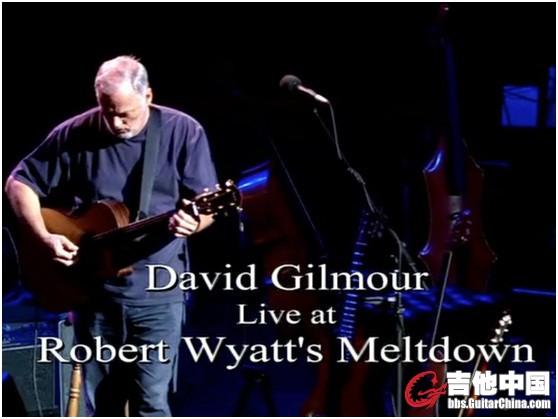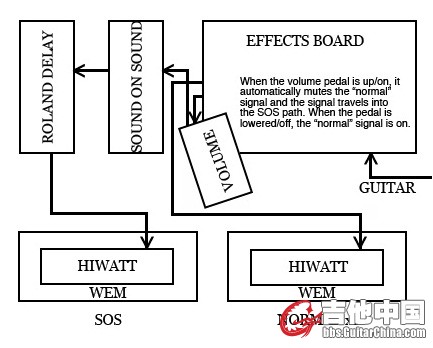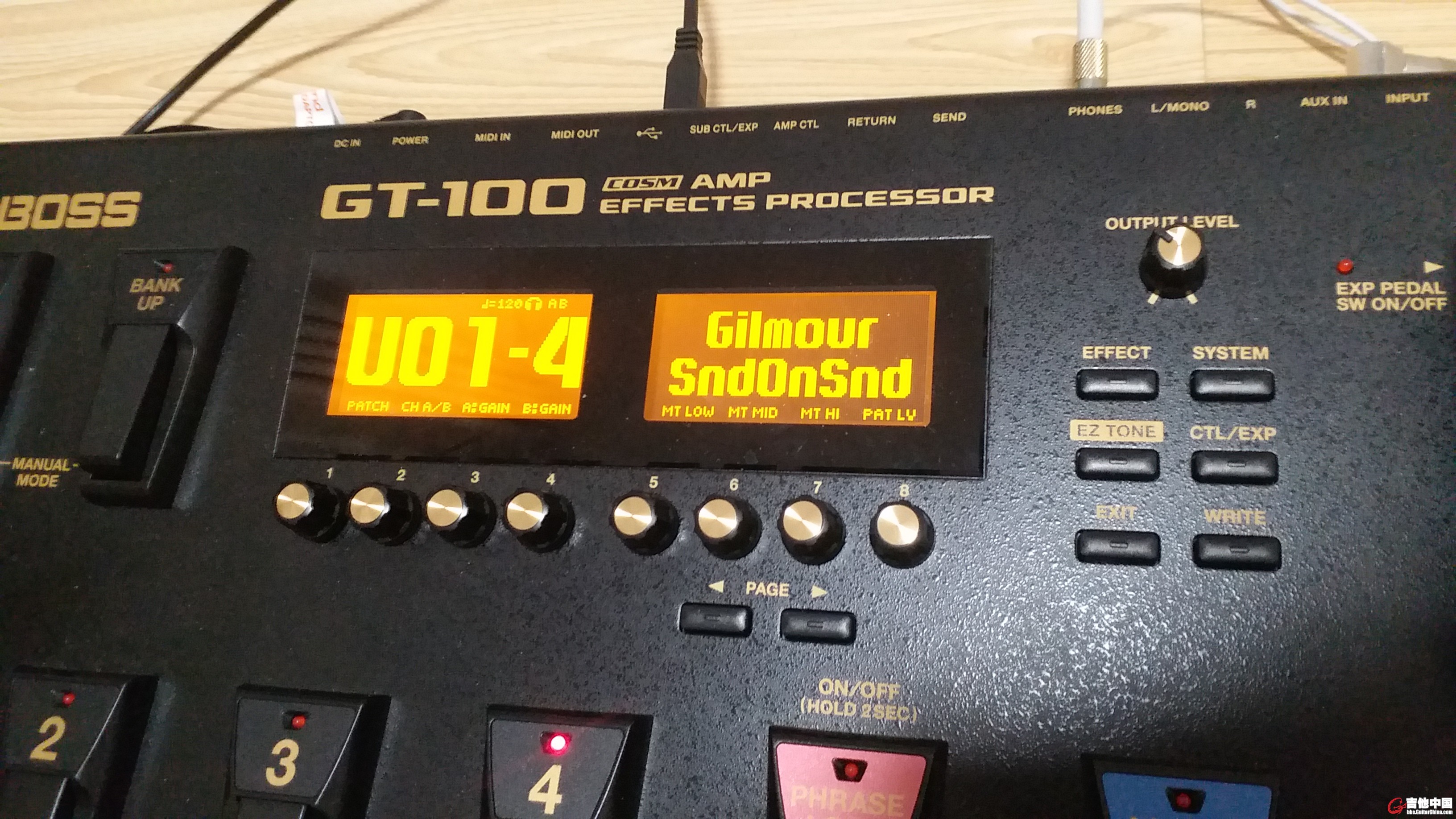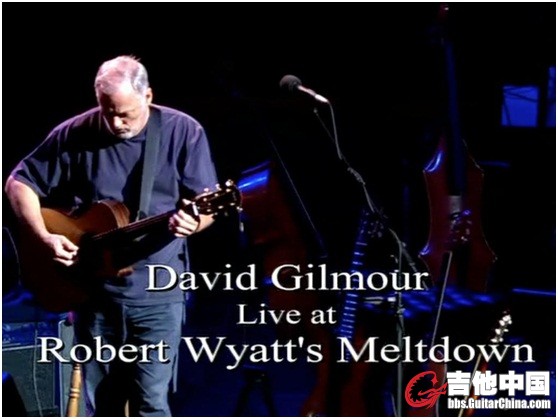|
|
本帖最后由 拉斯科尔尼科夫 于 2017-8-6 15:50 编辑
前言:
每当我努力完成一篇有质量的文章后,的确很累。一方面,苦于国内互联网上的资料匮乏,加之自己英语水准和智商又那么一般,另外一方面,也苦于日常工作和家务劳累,况且,写这些“干货”压根是无报酬的行为,哈哈,当然因为自己真心喜欢,同时也算是对自己的一个交代,所以独乐乐不如众乐乐,如果各位有幸看到此文并从中获得启发,本人深感荣幸和欣慰。
David Gilmour Sound on Sound效果浅谈
如果让我选择Pink Floyd里最喜欢的一首曲子,毫无疑问是Shine on You Crazy Diamond。
与大名鼎鼎的Comfortably Numb相比,钻石更多让人感到希望和力量。虽然我英语水准很蹩脚,但我觉得曲名上用了倒装手法,就像美元上In God We Trust,起到强调的作用,正常的顺序是Crazy Diamond Shine on You,当然,如果说得不对,请大家批评指正。OK,闲话不多,进入乐器方面的正题。
关于Sound on Sound效果
首先,什么SOS效果?是BOSS,TC或者Digitech的乐句循环上的声音叠加效果吗?不是的,请继续看下去
2001年大卫在Robert Wyatt’s Meltdown的现场中,用一把民谣吉他演绎了钻石前半部分(我还记得,在电脑上网还是56K调制解调器拨号的时代,观看了这段视频,仿佛就像昨天)

吉他中国论坛好像插不了视频了,姑且把地址贴一下吧
http://v.youku.com/v_show/id_XMjk0MDQ0ODM2OA==.html?spm=a2h3j.8428770.3416059.1
先来看一看gilmourish.com网站上关于这段演奏的介绍
Sound On Sound explained
The Sound on Sound effect was something David introduced on the 2001/02 acoustic shows. He wanted to be able to play Shine On without using keyboards and developed this technique of sustaining a chord with delay and playing on top of it.
The Sound on Sound effect, isn’t an effect in form of a pedal but rather the effect achieved when splitting the signal in two with a long delay assigned to one channel. David strums a chord and makes a volume swell with the volume pedal assigned for the Sound on Sound channel. The signal travels to the Sound on Sound unit (basically a A/B router unit made by Pete Cornish) and into the Roland digital delay, which is set to 1500ms lasting about 20 seconds. The signal then travels into a Hiwatt and WEM cabinet used only for this effect. Gilmour lowers the volume pedal and plays a solo fed through the “normal” signal path, while the Sound on Sound pad is sustained by the long delay. The pattern is repeated for each chord.
The effect can easily be achieved by using a delay with long repeats and an A/B splitting your signal into two cabinets. There’s also a couple of delay units that offers a Sound on Sound effect like the Boss DD-20 but it’s not quite the same.
署名Kit Rae的网友在其主页上也有类似介绍(摘录自www.kitrae.net)
SOUND ON SOUND
David had a special Sound-on-Sound rig built for playing a new acoustic version of Shine On You Crazy Diamond in his 2001-2002 Meltdown concerts. The rig allowed him to play sustained chords on the guitar which he could then play melody on top of. He had a similar setup built into his 2006 touring rig. One output from David's Mk II Cornish board went to his main Hiwatt amp and 4x12 speaker cabinets. The other output went to a Sound-on-Sound (S-O-S) interface build into David's rack, which fed a second Hiwatt amp and 4x12 speaker cabinet. The S-O-S unit was basically a buffered interface with two send/returns. The first send went to a volume pedal. The second send went to a Roland SDE 3000 digital delay in his rack, with inividual level controls for both the send and return, along with a mute switch. The SDE 3000 was set for a 1500ms delay and approximately 20-30 seconds of regenrated delay repeats.
David could play a chord, raise the volume pedal to send the signal into the SDE 3000, then lower the volume back to to zero. That delayed chord would ring on through the second Hiwatt for approximately 20-30 seconds before decaying, simulating a sustained keyboard chord. As the chord rang on, David could then play the melody lines through his main Hiwatt. He would do this for each chord change in the intro to Shine On You Crazy Diamond, effectively doing both the keyboard and guitar parts all by himself.
大致归纳一下上文所述:
1、大卫在2001/02年音乐现场上演示了Sound on Sound的效果,在没有键盘和其他乐器的情况下,大卫用一把吉他制造了一个延续性的和弦,然后在和弦里演奏旋律。
2、在这里,Sound on Sound不是一个单块或效果器上某个功能所制造出来的效果
3、大卫将吉他信号分割成了两路,分别进了两台Hiwatt音箱。
4、其中一条通道(Sound on Sound Channel),大卫用了很长的延迟(大约1500ms),然后用音量踏板(Volume Swells奏法)在这条信号上制造出一个长达20秒左右的,延续性的,光滑的,自然衰减的和弦。
5、大卫松开音量踏板,在持续性的和弦音下,通过另一条通道进行旋律独奏。
6、Pete Cornish帮大卫设计了这套设备(难怪他的东西卖这么贵)
7、用两台音箱和一个控制器可以比较容易的实现这种效果
8、Boss DD20上有类似的功能,EH有个Freeze单块也有类似效果,当然还有其他单块也提供类似效果,但这完全是两码事了
我们再看一下解释文字的两张逻辑图
图一(来自gilmourish.com)


看清楚了嘛,没那么复杂,此时我想你应该会更清楚的明白刚才我所说的
这里有2个关于音量踏板的问题要再拎出来讨论一下
1、音量踏板在效果链条中的不同位置产生效果有什么不同?
http://v.youku.com/v_show/id_XMjkzOTY2NzcwOA==.html?spm=a2h3j.8428770.3416059.1
A、音量踏板放在效果链条的顶端
此时,音量踏板控制着增益(Gain)的大小,作用相当于吉他上的音量旋钮,在JamPlay.com的视频中清楚的演示了当音量踏板由小到大,音色由Clean到Overdrive甚至Distortion的变化过程。此时,用踏板的好处是显而易见的,你用脚加以控制而不再用小指了,可以将注意全部集中在你的演奏上。
B、音量踏板放在失真/过载效果之后或者进FX Loop
此时,音量踏板控制的是Volume,也就是音量。增益的大小则由效果器或者音箱前级负责了。你可以在音量踏板之后加入调制或其他周边效果。如果配合一块不错的延迟,就可以做出很有氛围的Volmue Swell的音色,这将在下一个视频里进一步演示。我想,读者此时也明白我为何会说音量踏板的一些信息了,因为Sound on Sound里,大卫演奏的延续性和弦即是Volume Swell出来的效果。
2、用音量踏板怎么制造出氛围?
http://v.youku.com/v_show/id_XMjkzOTY3ODA1Ng==.html?spm=a2h3j.8428770.3416059.1
在这段Chords Of Orion视频中,将Volume Swell设置和演示做得相当清楚了,按照他的建议,用过载而不要用失真或者法滋,这样出来的效果会更好,更有氛围。同时,一块压缩也是很有必要的,它将提供更好的Sustain和Attack,各位可以自己动手试试看。在音量踏板的Volume控制下,清音或者略带过载的Swell信号经过延迟设备的自然衰减和回音下(如果有混响单块,最好在给点Decay残响),制造的如梦如幻,缠缠绵绵的效果音,棒极了!
好了,说了那么多基本知识,我想各位早就胸有成竹甚至有些不耐烦了
我最后谈一点实际操作层面上的技巧
手上有块Boss GT100正好有双音箱模拟功能,所以,为避免不必要的设备投资和连接两台扬声器和一堆连接线的麻烦,选择它再合适不过了。

翻弹的视频如下,非专业吉他手,粗糙简陋,各位见谅,听个意思就好
http://v.youku.com/v_show/id_XMjk0ODE0MTQ5Ng==.html?spm=a2h3j.8428770.3416059.1
1、 两条PreAmp通道都打开,因为用耳机,所以箱体模拟也开
2、 提一下表情踏板的设置:GT100的表情踏板除了控制音量外,必须在踩下的同时,将另外一个通道的音量成反比降低,直到为0,这样在混合点时,听上去音量比较均衡。
3、 踩踏板的感觉稍加练习,太快太慢都不太合适
4、 进行独奏的时,及时将踏板恢复到抬起状态,否则,你将听到延迟成一团糟的音符持续不断轰炸你和听众的耳朵。
5、 效果链条最后加点带Decay的混响。虽然混响是个很有争议的效果,但我个人觉得在此时登场还是比较合适的。
OK,这就是大卫的Sound on Sound,显而易见的,你的即兴练习又多了一个好玩的方法,玩得愉快!
|
-

|

